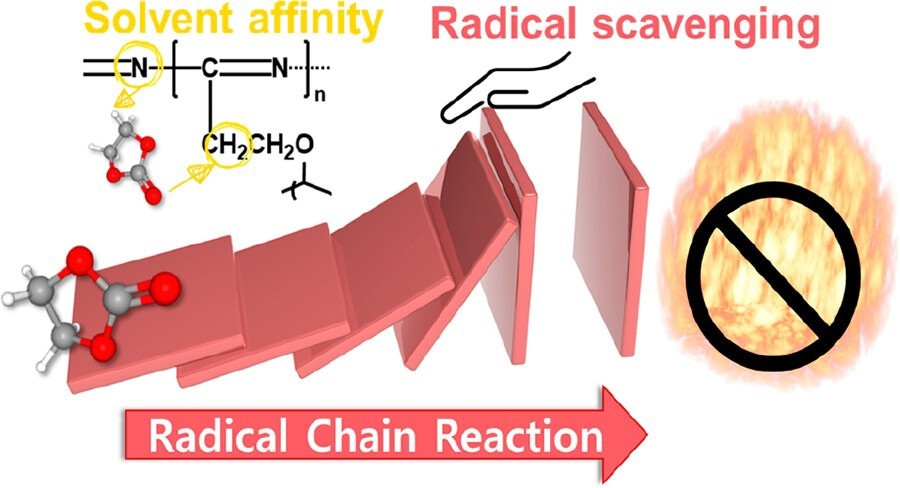A collaborative research team has achieved a significant breakthrough in battery technology.

Schematic image, depicting the principles of operation of non-flammable gel electrolytes. Image Credit: Ulsan National Institute of Science and Technology
The team was headed by Professor Hyun-Kon Song from the School of Energy and Chemical Engineering at UNIST, along with Dr. Seo-Hyun Jung from the Research Center for Advanced Specialty Chemicals at the Korea Research Institute of Chemical Technology (KRICT) and Dr. Tae-Hee Kim from the Ulsan Advanced Energy Technology R&D Center at the Korea Institute of Energy Research (KIER).
Their remarkable accomplishment involves the development of a non-flammable gel polymer electrolyte (GPE), which has the potential to revolutionize the safety of lithium-ion batteries (LIBs) by reducing the risks of thermal runaway and fire incidents.
Concerns regarding the flammability of LIBs have been particularly pronounced, notably in electric vehicles, where fire risks are a grave concern, particularly in underground parking facilities. In response to this pressing issue, the research team has achieved a groundbreaking breakthrough by creating a non-flammable polymer semi-solid electrolyte, which presents a hopeful solution to reduce the occurrence of battery fires.
Traditionally, non-flammable electrolytes have predominantly depended on the inclusion of flame-retardant additives or solvents with exceedingly high boiling points. Nonetheless, these approaches frequently led to a significant reduction in ion conductivity, thereby undermining the electrolyte's overall performance.
In their groundbreaking study, the research team integrated a small quantity of polymer into the electrolyte, resulting in a semi-solid electrolyte. This innovative technique led to a significant 33% enhancement in lithium-ion conductivity compared to conventional liquid electrolytes.
Furthermore, pouch-type batteries that utilized this non-flammable semi-solid electrolyte demonstrated a notable 110% advancement in their lifespan attributes, effectively averting undesired electrolyte reactions during the formation and operation of the solid-electrolyte interphase (SEI) layer.
The primary advantage of this pioneering electrolyte is its remarkable performance and non-combustible nature. Through the effective prevention of radical chain reactions involving fuel components during combustion, the polymer semi-solid electrolyte significantly reduces the likelihood of battery fires. The research team showcased the polymer's excellence by conducting a quantitative analysis of its capacity to stabilize and suppress radicals.
The interaction between the polymerized material inside the battery and volatile solvents allows us to effectively suppress radical chain reactions. Through electrochemical quantification, this breakthrough will greatly contribute to understanding the mechanism of non-flammable electrolytes.
Jihong Jeong, School of Energy and Chemical Engineering, Ulsan National Institute of Science and Technology
Mideum Kim, who served as a co-first author and is a Master's student in the School of Energy and Chemical Engineering at UNIST and the Korea Research Institute of Chemical Technology (KRICT), conducted additional experiments to validate the outstanding safety of the battery.
The research team's holistic methodology encompassed the integration of the non-flammable semi-solid electrolyte into pouch-type batteries, guaranteeing that the assessment of electrolyte non-combustibility extended to real-world battery applications.
The research team’s multidisciplinary composition, involving electrochemistry from UNIST, polymer synthesis from the KRICT Research Center for Advanced Specialty Chemicals, and battery safety testing by the Ulsan Advanced Energy Technology R&D Center at Korea Institute of Energy Research (KIER), has been instrumental in achieving this breakthrough. The use of non-flammable semi-solid electrolytes, which can be directly incorporated into existing battery assembly processes, will accelerate the future commercialization of safer batteries.
Hyun-Kon Song, Professor, School of Energy and Chemical Engineering, Ulsan National Institute of Science and Technology
The research study has filed for five patents within Korea and two additional ones internationally, underscoring the importance of this accomplishment. Furthermore, it has been chosen as a featured cover story in ACS Energy Letters.
The successful realization of this study was made possible through the backing of several organizations, including the National Research Foundation of Korea (NRF), the Ministry of Science and ICT (MSIT), the Korea Evaluation Institute of Industrial Technology (KEIT), the Korea Research Institute of Chemical Technology, and Samsung SDI Co., Ltd.
Journal Reference
Jeong, J., et al. (2023). Fire-Inhibiting Nonflammable Gel Polymer Electrolyte for Lithium-Ion Batteries. ACS Energy Letters. doi.org/10.1021/acsenergylett.3c01128.